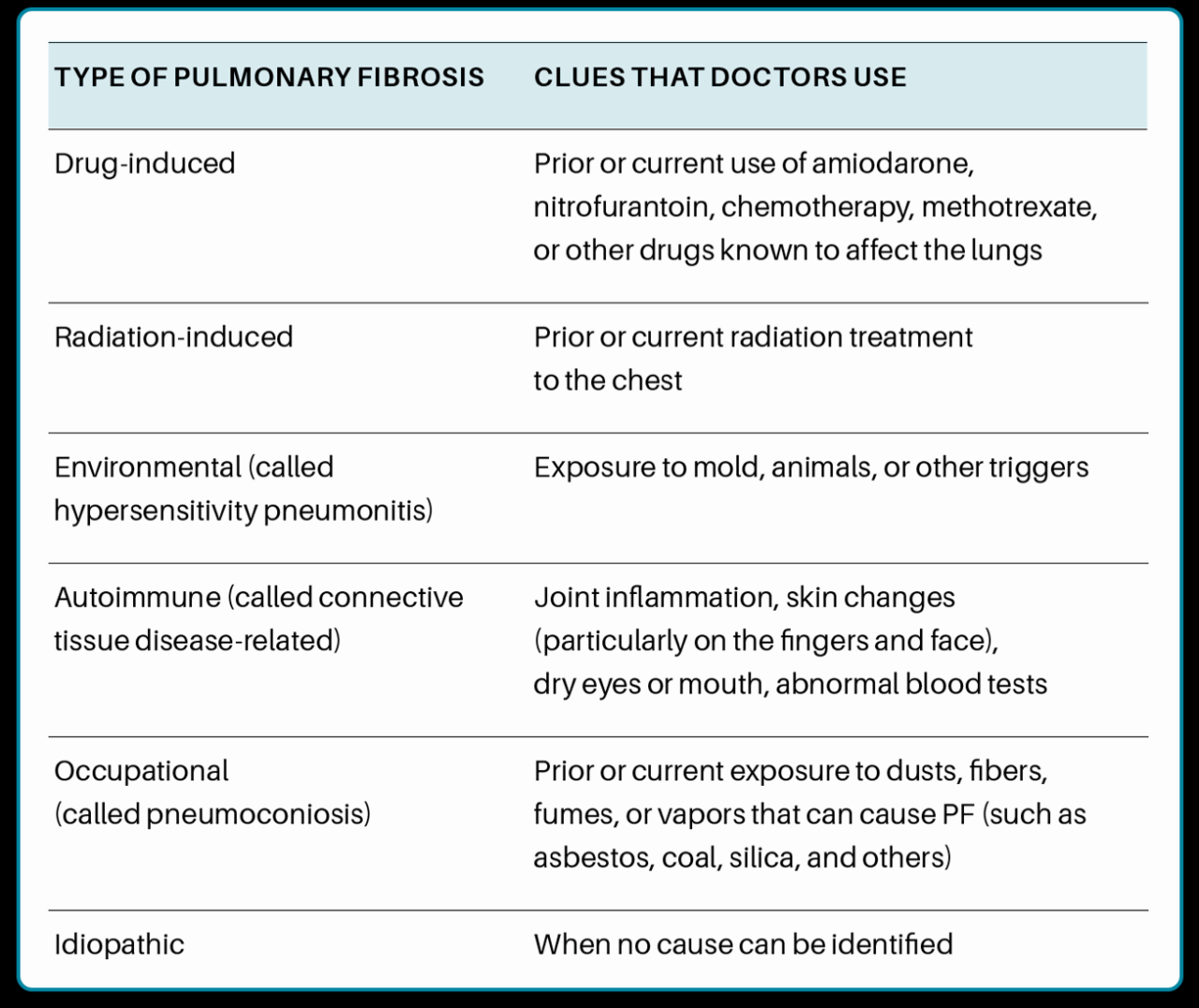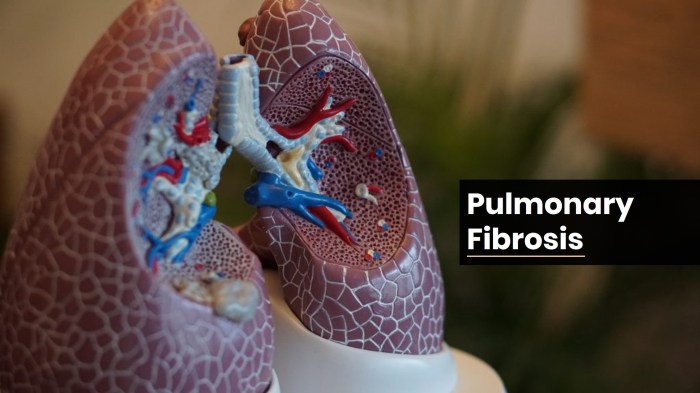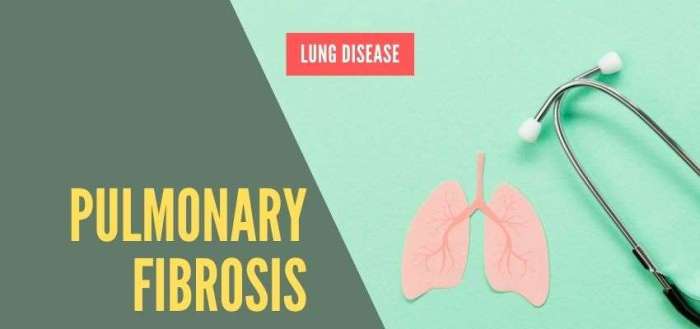Pulmonary fibrosis treatment offers a beacon of hope for individuals navigating the challenges of this debilitating lung condition. With a focus on understanding treatment options, symptom management, and the latest advancements, this comprehensive guide empowers patients and their loved ones to take an active role in their healthcare journey.
Pulmonary fibrosis, a scarring of the lung tissue, affects millions worldwide, leading to progressive shortness of breath and diminished quality of life. This guide delves into the intricacies of the disease, exploring its causes, symptoms, and diagnosis, equipping readers with a foundation for informed decision-making.
Definition of Pulmonary Fibrosis
Pulmonary fibrosis is a condition in which the lungs become scarred and thickened, making it difficult to breathe. The scarring can be caused by a variety of factors, including exposure to certain toxins, autoimmune diseases, and radiation therapy.
There are two main types of pulmonary fibrosis: idiopathic pulmonary fibrosis (IPF) and secondary pulmonary fibrosis. IPF is a condition of unknown cause, while secondary pulmonary fibrosis is caused by another underlying condition, such as an autoimmune disease or exposure to certain toxins.
Causes and Risk Factors
The exact cause of IPF is unknown, but it is thought to be caused by a combination of genetic and environmental factors. Some of the risk factors for IPF include:
- Age: IPF is more common in people over the age of 50.
- Smoking: Smoking is a major risk factor for IPF.
- Exposure to certain toxins: Exposure to certain toxins, such as asbestos, silica, and coal dust, can increase the risk of IPF.
- Family history: People with a family history of IPF are at an increased risk of developing the condition.
Secondary pulmonary fibrosis is caused by another underlying condition, such as an autoimmune disease or exposure to certain toxins. Some of the most common causes of secondary pulmonary fibrosis include:
- Autoimmune diseases: Autoimmune diseases, such as rheumatoid arthritis and lupus, can cause inflammation in the lungs that can lead to pulmonary fibrosis.
- Exposure to certain toxins: Exposure to certain toxins, such as asbestos, silica, and coal dust, can cause pulmonary fibrosis.
- Radiation therapy: Radiation therapy to the chest can damage the lungs and lead to pulmonary fibrosis.
Symptoms of Pulmonary Fibrosis

Pulmonary fibrosis is a chronic lung disease that causes scarring and thickening of the lung tissue, making it difficult to breathe. The symptoms of pulmonary fibrosis can vary from person to person and can progress over time.
Common Symptoms
- Shortness of breath, especially during exertion
- A dry cough that doesn’t go away
- Fatigue
- Chest pain or tightness
- Wheezing
- Loss of appetite
- Weight loss
- Clubbing of the fingers or toes
As the disease progresses, the symptoms can become more severe and can include:
- Difficulty breathing even at rest
- Cyanosis (bluish tint to the skin or lips)
- Respiratory failure
Pulmonary fibrosis can also affect a person’s daily life, making it difficult to perform everyday activities, such as walking, climbing stairs, or carrying objects. It can also lead to social isolation and depression.
Diagnosis of Pulmonary Fibrosis: Pulmonary Fibrosis Treatment

Diagnosing pulmonary fibrosis involves a combination of medical history, physical examination, and various diagnostic tests. These tests help to determine the extent of lung damage and rule out other conditions with similar symptoms.
Imaging Tests
Imaging tests, such as chest X-rays and high-resolution computed tomography (HRCT), are used to visualize the lungs and identify characteristic patterns of pulmonary fibrosis. Chest X-rays can show areas of scarring and inflammation, while HRCT provides more detailed images that can reveal the extent and distribution of fibrosis.
Lung Biopsy
In some cases, a lung biopsy may be necessary to confirm the diagnosis of pulmonary fibrosis. During a lung biopsy, a small sample of lung tissue is removed and examined under a microscope. This procedure can help to identify the specific type of fibrosis and exclude other conditions that may mimic pulmonary fibrosis.
Treatment Options for Pulmonary Fibrosis
Pulmonary fibrosis is a progressive lung disease that causes scarring and thickening of the lung tissue, making it difficult to breathe. While there is no cure for pulmonary fibrosis, there are treatment options available to slow the progression of the disease and improve symptoms.
Medications, Pulmonary fibrosis treatment
Medications used to treat pulmonary fibrosis include:
- Pirfenidone (Esbriet):This medication helps slow the progression of the disease by reducing inflammation and fibrosis.
- Nintedanib (Ofev):This medication also helps slow the progression of the disease by blocking the action of certain proteins that contribute to fibrosis.
- Anti-inflammatory medications:These medications, such as corticosteroids, can help reduce inflammation in the lungs.
Therapies
Therapies used to treat pulmonary fibrosis include:
- Oxygen therapy:This therapy provides supplemental oxygen to improve breathing.
- Pulmonary rehabilitation:This program of exercise and education helps improve breathing and overall fitness.
- Lung transplant:In severe cases, a lung transplant may be necessary to replace damaged lung tissue.
Surgical Procedures
Surgical procedures used to treat pulmonary fibrosis include:
- Pleural effusion drainage:This procedure involves draining excess fluid from the pleural space, the space between the lungs and the chest wall.
- Lung volume reduction surgery:This surgery removes damaged lung tissue to improve breathing.
Effectiveness and Side Effects
The effectiveness of treatment options for pulmonary fibrosis varies depending on the individual patient and the stage of the disease. Medications and therapies can be effective in slowing the progression of the disease and improving symptoms, but they can also have side effects such as nausea, diarrhea, and fatigue.
Surgical procedures can be more invasive and have a longer recovery time, but they can also be more effective in improving breathing.
Prognosis and Management of Pulmonary Fibrosis
Pulmonary fibrosis is a progressive disease, meaning it worsens over time. The prognosis of pulmonary fibrosis varies depending on the type and severity of the disease. In general, people with mild pulmonary fibrosis have a good prognosis and can live for many years with minimal symptoms.
However, people with severe pulmonary fibrosis have a poorer prognosis and may only live for a few years. The median survival time for people with severe pulmonary fibrosis is about 3 years.
There is no cure for pulmonary fibrosis, but there are treatments that can help to slow the progression of the disease and improve quality of life. These treatments include medications, oxygen therapy, and pulmonary rehabilitation.
Disease Management
Disease management is important for people with pulmonary fibrosis. By following a healthy lifestyle and taking medications as prescribed, people with pulmonary fibrosis can improve their quality of life and slow the progression of the disease.
A healthy lifestyle for people with pulmonary fibrosis includes:
- Eating a healthy diet
- Getting regular exercise
- Avoiding smoking
- Getting enough sleep
Medications for pulmonary fibrosis include:
- Anti-inflammatory drugs
- Immunosuppressants
- Pirfenidone
- Nintedanib
Oxygen therapy is another important treatment for pulmonary fibrosis. Oxygen therapy can help to improve breathing and reduce shortness of breath.
Pulmonary rehabilitation is a program of exercise and education that can help people with pulmonary fibrosis to improve their quality of life. Pulmonary rehabilitation can help to:
- Increase exercise capacity
- Reduce shortness of breath
- Improve quality of sleep
- Increase independence
Support Groups and Patient Education
Support groups and patient education can be helpful for people with pulmonary fibrosis. Support groups provide a place for people with pulmonary fibrosis to connect with others who are going through the same experience. Patient education can help people with pulmonary fibrosis to learn more about the disease and how to manage it.
There are a number of support groups and patient education resources available for people with pulmonary fibrosis. Some of these resources include:
- The Pulmonary Fibrosis Foundation
- The American Lung Association
- The National Institute of Health’s National Heart, Lung, and Blood Institute
Current Research and Advancements in Pulmonary Fibrosis Treatment

Significant research efforts are underway to develop new and more effective treatments for pulmonary fibrosis. These efforts involve exploring various approaches, including new medications, therapies, and clinical trials.
One promising area of research focuses on antifibrotic medications. These medications aim to slow down or stop the scarring process in the lungs. Several antifibrotic medications have been approved for use in pulmonary fibrosis, and ongoing research continues to investigate their long-term effectiveness and safety.
Clinical Trials
Clinical trials play a crucial role in advancing pulmonary fibrosis treatment. These trials involve testing new therapies and medications in human subjects to assess their safety and effectiveness. Participation in clinical trials offers patients access to potential new treatments and contributes to the advancement of medical knowledge.
Researchers are also exploring the potential of stem cell therapy and gene therapy for pulmonary fibrosis. These approaches aim to repair damaged lung tissue or correct genetic defects that contribute to the disease.
Ultimate Conclusion
Managing pulmonary fibrosis requires a multifaceted approach that encompasses medication, lifestyle modifications, and emotional support. By embracing a proactive approach, individuals can mitigate symptoms, improve their overall well-being, and live fulfilling lives despite the challenges posed by this condition.
Ongoing research holds the promise of new and improved treatments for pulmonary fibrosis. With clinical trials and innovative therapies on the horizon, the future of pulmonary fibrosis management looks brighter than ever. This guide serves as a valuable resource for patients, caregivers, and healthcare professionals alike, providing a comprehensive understanding of pulmonary fibrosis treatment and empowering them to navigate the complexities of this condition.
Expert Answers
What are the common symptoms of pulmonary fibrosis?
Shortness of breath, dry cough, fatigue, and chest discomfort are common symptoms.
How is pulmonary fibrosis diagnosed?
Diagnosis involves a combination of physical examination, imaging tests, and lung biopsy.
What are the treatment options for pulmonary fibrosis?
Treatment options include medications, oxygen therapy, pulmonary rehabilitation, and lung transplant in severe cases.
How does pulmonary fibrosis affect daily life?
It can limit physical activity, impact sleep, and affect emotional well-being.
What is the prognosis for pulmonary fibrosis?
Prognosis varies depending on the type and severity of the disease, but with proper management, many patients can live well with the condition.